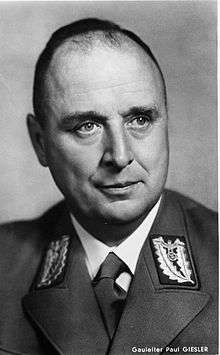Paul Giesler
| Paul Giesler | |
|---|---|
 | |
| Minister President of Bavaria | |
|
In office 2 November 1942 – 28 April 1945 | |
| Preceded by | Ludwig Siebert |
| Succeeded by | Fritz Schäffer |
| Reich Minister of the Interior | |
|
In office 29 April 1945 – 6 May 1945 | |
| Appointed by | Adolf Hitler |
| President |
Adolf Hitler (Führer) Karl Dönitz |
| Chancellor |
Adolf Hitler Joseph Goebbels Lutz Graf Schwerin von Krosigk (Leading Minister) |
| Preceded by | Heinrich Himmler |
| Succeeded by | Wilhelm Stuckart |
| Personal details | |
| Born |
15 June 1895 Siegen, Westphalia |
| Died |
8 May 1945 (aged 49) Berchtesgaden |
| Nationality | German |
| Political party | Nationalsozialistische Deutsche Arbeiter Partei |
| Religion | Lutheranism |
Paul Giesler (15 June 1895 – 8 May 1945) was a member of the Nazi Party, from 1941 Gauleiter of Westphalia-South (Westfalen-Süd) and as of 1942 also acting Gauleiter of the Gau Munich-Upper Bavaria (Gau München-Oberbayern). He was from 2 November 1942 to 28 April 1945 the Premier (Ministerpräsident) of Bavaria.
Biography
The trained architect was from 1924 a Party speaker, an SA leader, and NSDAP district leader (Ortsgruppenleiter). During the Night of the Long Knives he only narrowly missed being arrested and murdered. He served in the Poland and France campaigns. Only from August 1941 did Giesler once again take up important Party functions, at Martin Bormann's instigation, first becoming NSDAP Gauleiter of Westphalia-South in 1941, and then as of April 1942 Adolf Wagner's successor as acting Gauleiter of Munich-Upper Bavaria. After Ludwig Siebert's death on 1 November 1942, he was also appointed acting Ministerpräsident of Bavaria. As the war continued, he took up more and more ministerial posts, especially after Wagner's death.
In Munich, Giesler was known for speaking out against higher education for women, provoking student walk-outs of his speeches. He was also known for the capture and defeat of the White Rose (Weiße Rose) student resistance movement. In April 1945, he was appointed Reich Defence Commissar-South and with help from SS units brutally quelled the "Freedom Action Bavaria" ("Freiheitsaktion Bayern") uprising under Captain Dr. Rupprecht Gerngroß in Munich. Reflecting Giesler's fanatically loyal Nazi outlook he was named Reich Minister for the Interior in Adolf Hitler's will of 29 April 1945, though he never had the chance to assume this post.
As American troops approached, Giesler was reported to be planning the murder of the surviving inmates at Dachau concentration camp and several of its satellite camps in March 1945, on the authority of Ernst Kaltenbrunner, Chief of the RSHA. In a 20 November 1945 interrogation of Giesler's Gaustabsamtsleiter, Hubertus "Bertus" Gerdes by Special Agent Johannes Imhoff of the Counter Intelligence Corps (CIC), Nürnberg Sub-Regional Office, Gerdes spoke of his role in sabotaging the plans for mass murder. In August, 1946, in testimony given to the International Military Tribunal by Karl Fredrich Freiherr von Eberstein, he claimed he was ordered to use his influence with the commandant of Dachau (SS-Obersturmbannführer Eduard Weiter) to have 25,000 prisoners shot when the U.S. approached. If this couldn't be done, then Giesler, in his capacity as Reich Defense Commissar, would order the Luftwaffe to bomb the camp. Eberstein refused to order the shooting of the prisoners and stated that it would be impossible to find any Luftwaffe commander to give the order to bomb. Giesler then said he would poison the prisoners; Eberstein claimed he stopped Giesler by obtaining an order from Himmler to simply surrender the camps. Giesler then fired Eberstein on 20 April, on orders of Martin Bormann, for 'defeatism'.[1][2]
During the last chaotic days of Nazi Germany, Giesler was behind the worst of the violence directed against "defeatists" and those seeking to surrender their districts without pointless destruction, the Penzberger Mordnacht (Night of Penzberg Murder) being one of the best known examples of this. When it was reported to Giesler that three people had been shot in another incident in Burghausen he retorted "What, only three ? ("The End" - Ian Kershaw - p. 344).
On 8 May 1945, the day that the Nazi capitulated to the Allies, Giesler and his wife committed suicide, fearing capture by American troops as they fled Berchtesgaden. A local doctor practicing in Stanggass at that time, Dr. Gottschalk, certified Giesler's death on 8 May 1945 and he was buried in the cemetery in Berchtesgaden on 10 May 1945. His remains were later disinterred and reburied elsewhere.
Giesler was an unquestioning follower of Hitler, who ruled with ruthless efficiency and almost unlimited power in the last war years in Bavaria.[3]
Notes
Sources
- Bosl, Karl. "Paul Giesler". Bosls bayrische Biographie (in German). Universitätsbibliothek Regensburg, and Pustet. pp. 254–255. Retrieved 17 February 2009.
- International Military Tribunal, Trial of the Major War Criminals (5 August 1946). "Nuremberg Trial Proceedings Volume 20, Day 195". Avalon Project, Lillian Goldman Law Library, Yale Law School. Also William S. Hein & Co. Inc. Retrieved 31 December 2008.
- Yerger, Mark C. (1997). Allgemeine-SS. The commands, units, and leaders of the General SS. Atglen, PA: Schiffer Publishing Ltd. ISBN 0-7643-0145-4.
- Miller, Michael D. and Schulz, Andreas (2012). Gauleiter: The Regional Leaders Of The Nazi Party And Their Deputies, 1925-1945 (Herbert Albrecht-H. Wilhelm Huttmann)-Volume 1. James Bender Publishing.
External links
- Detailed biography of Paul Giesler (Historisches Centrum Hagen)
- Town of Siegen: Paul Giesler's life path
- Hitler's will from 29 April 1945 (all in German)
- Picture of Paul Giesler, undated Historisches Lexikon Bayerns
.svg.png)